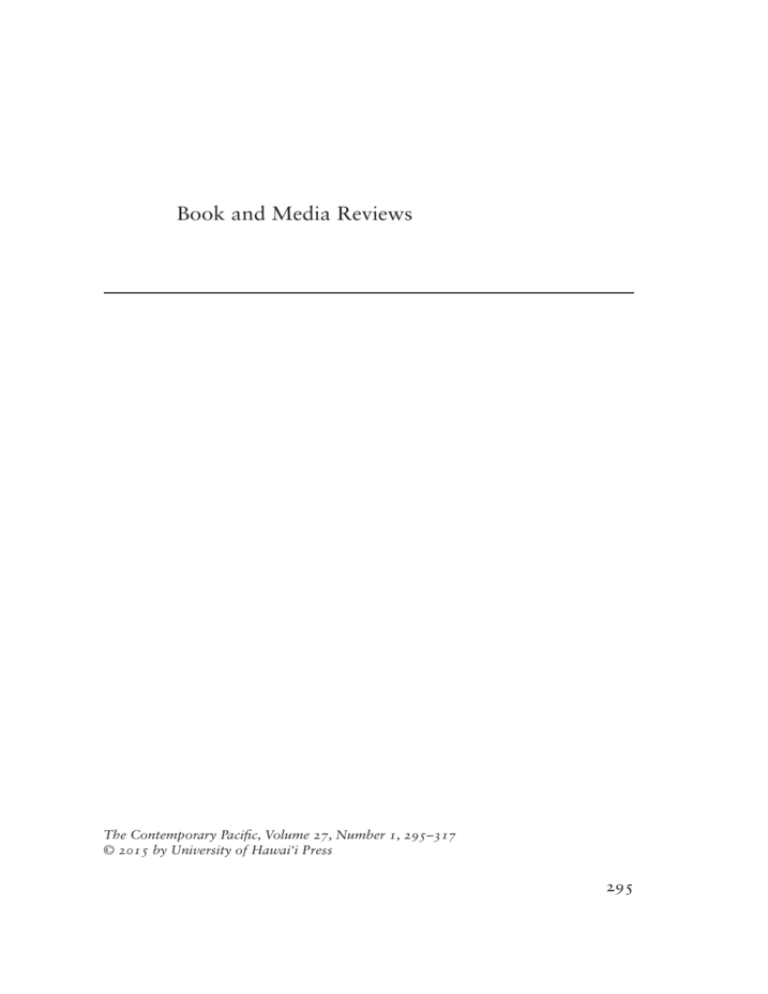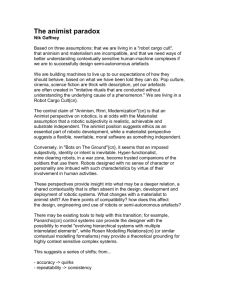
Book and Media Reviews
The Contemporary Pacic, Volume 27, Number 1, 295–317
© 2015 by University of Hawai‘i Press
295
book and media reviews
Living Along the Fenceline. Documentary, 65 minutes, color, 2011.
Codirected by Gwyn Kirk and Lina
Hoshino; produced and written
by Lina Hoshino, Gwyn Kirk, and
­Deborah Lee. Distributed by Women
for Genuine Security. Available at
http://www.alongthefenceline.com;
home use us$20.00, community
use us$50.00, public library use
us$100.00, public/educational use
us$250.00.
As the United States military once
again shifts its gaze toward Oceania
during what Hillary Clinton calls
“America’s Pacific Century,” new
questions are being raised about what
this pivot could mean for Island communities. Addressing the question,
“What is genuine security?” from
the critical perspective of women’s
voices and experiences, Gwyn Kirk
and Lina Hoshino’s Living Along the
Fenceline provides a welcome tool
for understanding the lived experiences of those whose communities
have had to bear the brunt of the US
military-industrial complex’s emerging
agenda. This documentary travels to
Texas, Vieques (in Puerto Rico), the
Philippines, South Korea, Okinawa,
Guåhan (Guam), and Hawai‘i in
order to highlight the different ways
in which seven women are addressing
the environmental, health, sovereignty,
and sexual impacts of militarism in
their regions. Rather than engaging
such weighty issues through too easily
depersonalized mass demilitarization
movements, these women humanize
the trauma of militarization by offering the audience a glimpse into their
everyday lives. Through Living Along
the Fenceline, this diverse group of
313
women share compelling stories of
how they combat the impacts of militarization in their homelands, making
possible a narrative that challenges
viewers to reconsider the repercussions
of an ever-rising militarism within and
around Oceania.
Kirk and Hoshino’s documentary
not only meticulously maps out the
problematic ways the US military
affects the communities outside its
bases but also draws much-needed
attention to the experiences of women
who reside within militarized spaces.
By engendering a discussion of militarization across various countries that
host the US military, and by sensitively
addressing aspects of engagements,
encounters, and entanglements, Living
Along the Fenceline makes it easier to
understand the nuanced yet related
ways the military disenfranchises
those outside their bases. Starting in
San Antonio, Texas, Diana Lopez
shows how her city is economically
dependent on the surrounding eight
military bases. This has meant not
only high rates of recruitment from
the city but also devastating impacts
on the environment due to dumping
of toxic waste into local waterways.
With strong parallels and overlapping
­stories, Terri Keko‘olani of Hawai‘i
and Lisa Natividad of Guåhan, as
indigenous women of the Pacific,
discuss the military colonialization
of their Island homes, which has led
to health disparities, loss of ancestral
lands, and violations of self-determination. While many of the women’s
experiences shed light on the environmental degradation of their homes,
other stories focus on the sexual
violence that women have experienced. In Okinawa, Yumi Tomita (an
314
the contemporary pacific • 27:1 (2015)
Okinawan pseudonym) challenges
the idea of genuine security for those
around military bases by describing
her own abduction and rape by two
American soldiers. While each story is
personal and subjective, together these
accounts represent a larger history of
the continuing use of the US military
as a tool for colonization.
With striking sensitivity and
­frankness, Kirk and Hoshino have
realized an accessible and thoughtprovoking film that powerfully
­examines the sociopolitical com­
plexities of militarization. These
complexities are revealed at points
of contention where colonial histories rooted in military economies
meet the environments and bodies of
these women. Along with shedding
light on all-too-often o
­ verlooked yet
utterly significant moments of military
violence, Living Along the Fenceline
shows how these resilient women have
become community ­leaders in their
respective communities by fighting
for healing among their people and
pushing for a demilitarized future.
Through her organization, Buklod
ng Kabbaihan (Unity of Women),
Alma Bulawan of Olongapo, Philippines, offers support to women who
are facing the pressures of poverty by
participating in a t­ hriving prostitution
scenario. This and comparable stories
of individual and collective struggles
and ­achievements in everyday contexts
work well as interconnected pieces
that challenge mainstream ideas of
the security and necessity of the US
military. This film is a valuable addition to conversations surrounding the
growth of the US military-industrial
complex and helping to create new
dialogue about the specificities of how
women are incorporated into this
global project.
While Living Along the Fenceline
is clear about the interconnectedness
of these women’s stories, the film falls
short of equipping its audience with
the conceptual and contextual tools
necessary to make sense of the larger
colonial history that many of these
countries share. For instance, there
is no mention of how Puerto Rico,
Hawai‘i, Guåhan, and the Philippines
were all acquired by the United States
as prizes of war following the SpanishAmerican War, allowing the United
States to expand its national borders. While Kirk and Hoshino focus
much of their attention on educating
their audience about the contemporary impacts of sexual violence in
­Okinawa, there is little discussion of
how a shared colonial history will
see the largest contemporary military buildup to take place in Guåhan
through the displacement of American
troops from Okinawa. These colonial links and shared histories today
influence the movement of the US
military and deserve a closer examination, which is perhaps not possible
given the filmmakers’ constraints and
entirely welcome perspective on some
of the gendered dimensions of contemporary Pacific militarization.
Living Along the Fenceline’s release
comes at a poignant time when the US
military presence in Oceania is both
dramatically increasing and perhaps
changing in character as the United
States prepares for its Pacific pivot.
This film offers an often-overlooked
perspective on the harmful impacts
with which communities around military bases must deal. The strength of
Kirk and Hoshino’s work is its ability
book and media reviews
to interrupt the dominant discourse
that US militarism enables security for
the global community. These women’s
stories make possible new conversations that address the multilayered
ways in which militarism can have
lasting impacts on communities both
within and along expanding boundaries of command and control.
jesi lujan bennett
University of Hawai‘i, Mānoa
*
*
*
Cargo Cult. Animated film, 11 minutes, 2013. Sacrebleu Productions.
Directed by Bastien Dubois, written
by Bastien Dubois with the collaboration of Gaia Guasti, produced by
Ron Dyens. For availability, contact
the producers via the film website:
www.bastiendubois.com/cargo/.
Back in 1958, Pacific Islands Monthly
subtitled one of its articles with the
complaint “The Cargo Cult Won’t Die
Quietly in the Pacific.” In years since,
despite numerous similar predictions
that cargo cults will soon give up
their ghosts as the darker Melanesian
corners are infused with new lights of
education, economic development, and
steadier rationality, cargo cult lives
still. Actual culting in these islands
has indeed faded away—or, rather,
it has morphed into arresting forms
of political organization, charismatic
Christianity, health and wealth gospel,
and global Internet scams. But cargo
cult vigorously endures in popular literature, travel writing, art, music, and
film. Despite anthropological unease
and even firm repudiation of the label,
cargo cult is proving impossible to kill.
A quick check of amazon.com finds
315
on sale three new Kindle cargo-cult
novels (one about Tanna’s John Frum
movement; another offering a dash of
science fiction; and the third about the
US Pacific Northwest); a cargo-cult
travelogue (again about John Frum);
and a full rack of cargo-cult music
cds.
To all this we can add Sacrebleu’s
animated short, Cargo Cult. Sacrebleu Productions, headquartered in
Paris, produces animated and live
short films, features, and documentaries. Bastien Dubois, Cargo Cult’s
director and co-writer, has completed
several other short animation projects, including Madagascar, carnet de
voyage, which was nominated for an
Academy Award for best animated
short film in 2011. This features a
Malagasy ritual of reburying the dead.
Apart from its being a similarly exotic
theme, viewers may well wonder how
cargo cult caught the animator’s eye.
Gaia Guasti, who collaborated on the
script, writes young adult novels.
Dubois’s animated cargo cult—
drawn in lush island greens and
blues—rewinds the story back to the
Pacific War. Without much dialogue except for cargoist debate in
an unspecified Melanesian tongue
without subtitles, the film’s only plain
words are an introductory epigram
from science fiction writer Arthur
C Clarke: “Any sufficiently advanced
technology is indistinguishable from
magic.” The opening scene illustrates this conceit. A huge, hulking,
black warship overtakes and overshadows an island canoe. We next
see an American airbase as the film
follows the familiar cargo storyline.
An Islander has crept onto the base,
dodging jeeps, planes, Quonset huts,








